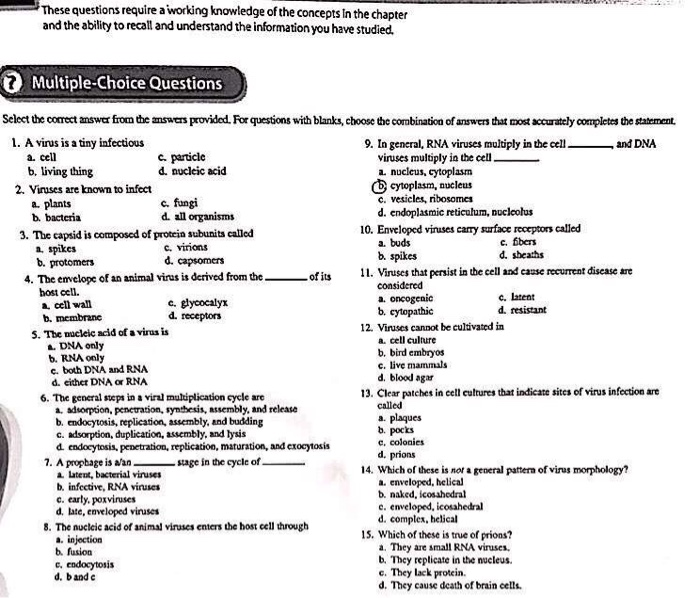These questions require a iworking knowledge of the concepts In the chapter and the ability to recall and understand the information you have studied. 7Multiple-Choice Questions Select the correct answer from the mswers provided. For questions with blanks, choose the combination of answers that most accuately completes the statement 1. A virus is a tiny infectious a. cell 9. In general, RNA viruses multiply in the cell. viruses multiply in the cell. a. nucleus, cytoplasm cytoplasm, nucleus c. vesicles, ribosomes d. endoplasmic reticulum, nucleolus 10. Enveloped viruses carry surface receptors called a. buds b. spikes 1. Viruses that persist in the cell and cause recurrent discase are coasidered a. oncogenic b. cytopathic , and DNA c. particle d. nucleic acid b. living thing 2. Viruses are known to infect a. plants b. bacteria c fangi d. all organisms 3. The capsid is composed of protein subunits called a. spikes d. protomers 4. The envelope of an animal virus is derived from the host cell a cell wall b. membranc c. fbers d. sheaths c. virions d. capsomers of its c. latent G. glycocalyx d. receptors d. resistant 12. Viruses cannot be cultivated in a. cell culture b. bird embryos c. live mammals d. blood agar S. The macleic acid of a virus is a. DNA only b. RNA only c. both DNA and RNA d. either DNA or RNA 13. Clear patches in cell eultures that indicate sites of virus infection are called 6. The general steps in a viral multiplication cycle are a. adsorpion, penetration, synthesis, assembly, and release b. endocytosis, replication, assembly, and budding c. adsorption, duplication, assembly, and lysis d endocytosis, penetration, replication, maturation, and exocytosis plaques b. pocks c, colonies d. prions 14. Which of these is nor a general paterrn of virus morphologgy? a. enveloped, helical b. naked, icosahedral c. enveloped, icosahedral d. comples, helical 1S. Which of these is true of prions? They are small RNA viruses b. They replicate in the nucleus c. They lack protein d. They cause death of brain cells a. stage in the cycle of 7. A propbage is a/an a latent, bacterial viruses b. infective, RNA viruses c. early, poxviruses d. late, enveloped viruses 8. The nucleic acid of animal viruses enters the host cell through a. injection b. fusion a. c. endocytosis d. band e







